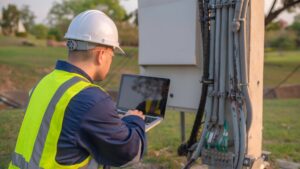As a Network Maintenance Manager, your responsibilities span a wide array of critical tasks, from monitoring network performance and troubleshooting issues to ensuring compliance with regulatory standards and managing budgets. Your primary objectives are to minimize downtime, enhance network reliability, and optimize performance—all while navigating the complexities of aging infrastructure and stringent regulatory requirements. In this context, leveraging modern technology solutions, such as cloud-based physical access control, can significantly enhance your ability to meet these objectives and address some of the persistent pain points in your role.
Industry Example: Telecom Signaling Networks

In the realm of telecommunications, ensuring the security and reliability of signaling stations is paramount. Cloud-based physical access control systems provide a robust solution by enabling smartphone (mobile phone) access. This technology allows you to manage and monitor access to critical infrastructure in real-time, ensuring that only authorized personnel can enter sensitive areas.
With flexible access authorization, you can quickly grant or revoke access remotely, which is especially useful during emergencies or when dealing with temporary contractors. Real-time monitoring and alerts help you detect unauthorized access attempts immediately, allowing for swift action to prevent potential disruptions. This level of control not only enhances security but also ensures compliance with regulatory requirements by maintaining detailed logs of all access events.
Industry Example: Power Generation and Distribution

Power generation and distribution networks are equally critical and often spread over large geographical areas, making physical security a challenge. Cloud-based access control systems address this by offering centralized management of multiple sites. With mobile access, maintenance teams can quickly gain entry to remote substations or generation facilities without the need for physical keys, reducing the time spent on administrative tasks and enhancing operational efficiency.
The ability to manage access remotely is particularly beneficial for scheduled maintenance and emergency response situations. You can ensure that only trained and authorized personnel are on-site, reducing the risk of accidents and improving safety protocols. Additionally, the detailed access logs support compliance with industry standards and help in incident investigations, providing a clear audit trail of who accessed what and when.
Industry Example: Renewable Energy

Renewable energy installations, such as wind parks, often operate in isolated and harsh environments. Ensuring the security and proper maintenance of these facilities is crucial for their efficient operation. Cloud-based physical access control systems facilitate the management of these remote sites by allowing access via smartphones, thereby eliminating the logistical challenges associated with physical key distribution.
Real-time monitoring ensures that any unauthorized access attempts are immediately detected, which is vital for protecting these often remote and vulnerable assets. The system’s flexibility in access authorization means that maintenance schedules can be managed more effectively, with technicians granted access only when needed, thereby optimizing resource allocation and reducing the risk of unauthorized or unnecessary access.
Conclusion
For Network Maintenance Managers like Jamie Parker, cloud-based physical access control offers a transformative solution to many of the challenges inherent in your role. By enabling smartphone access, providing flexible and remote access management, and offering real-time monitoring and detailed audit trails, these systems enhance security, ensure compliance, and improve operational efficiency across telecommunications, power generation, and renewable energy sectors. Embracing this technology not only supports your key objectives of minimizing downtime and enhancing reliability but also addresses critical pain points such as managing aging infrastructure, meeting regulatory requirements, and optimizing workforce management.
Investing in cloud-based physical access control is a strategic move that empowers you to meet your responsibilities more effectively and ensures the robustness and security of your infrastructure.



